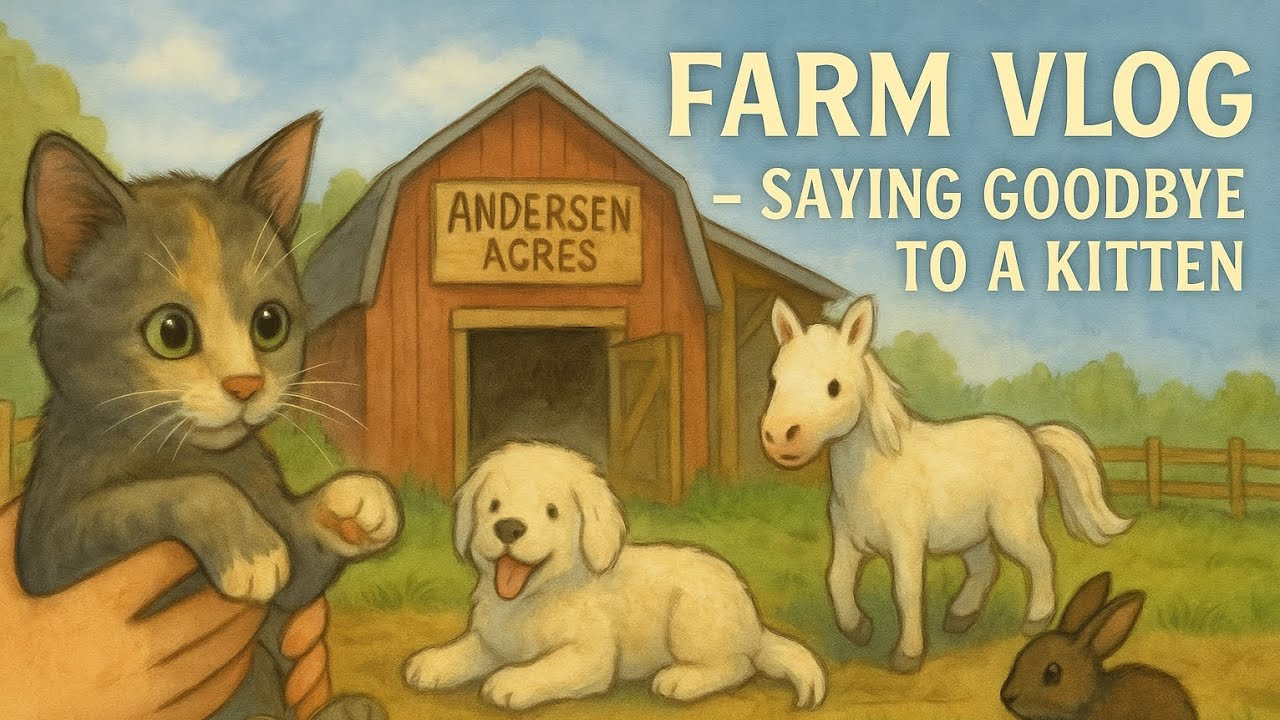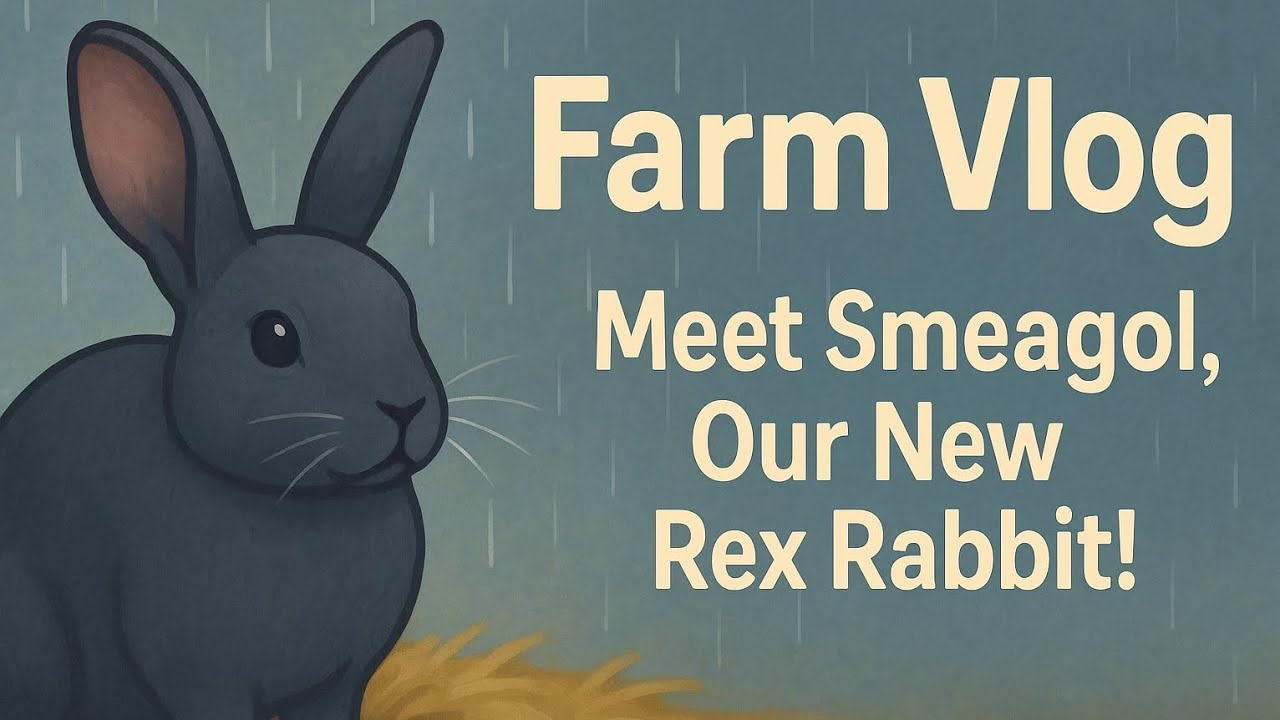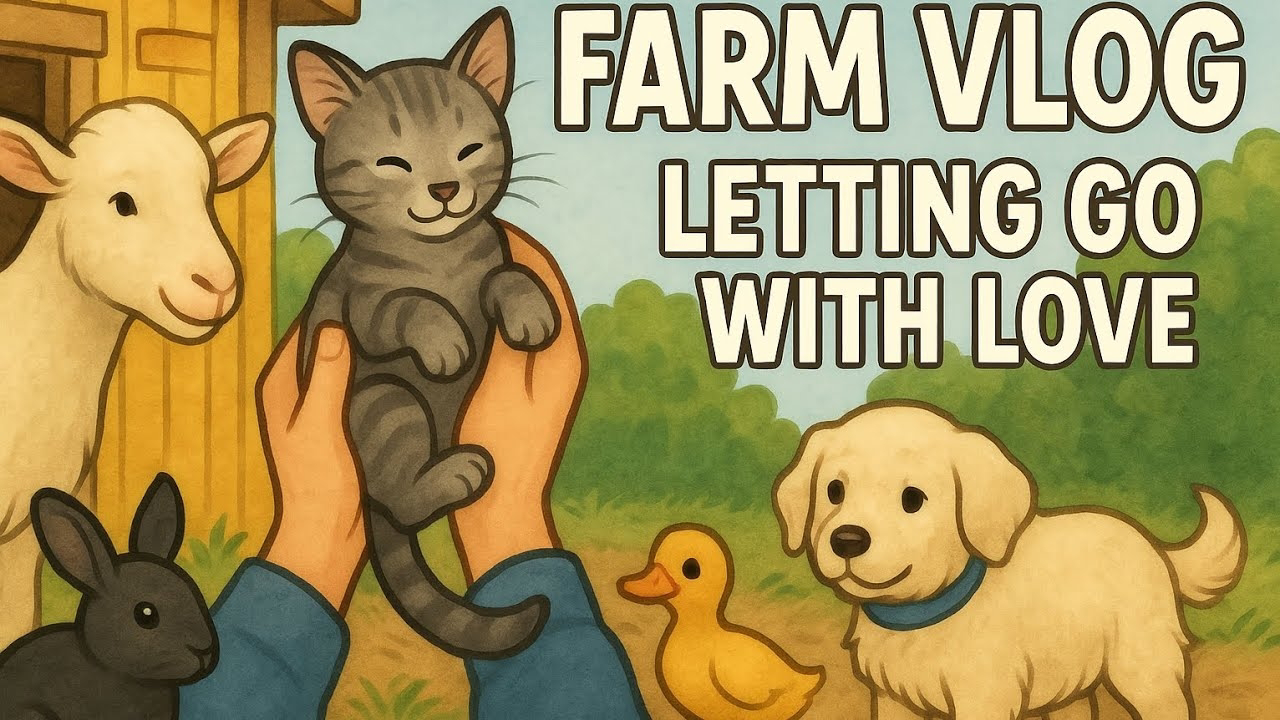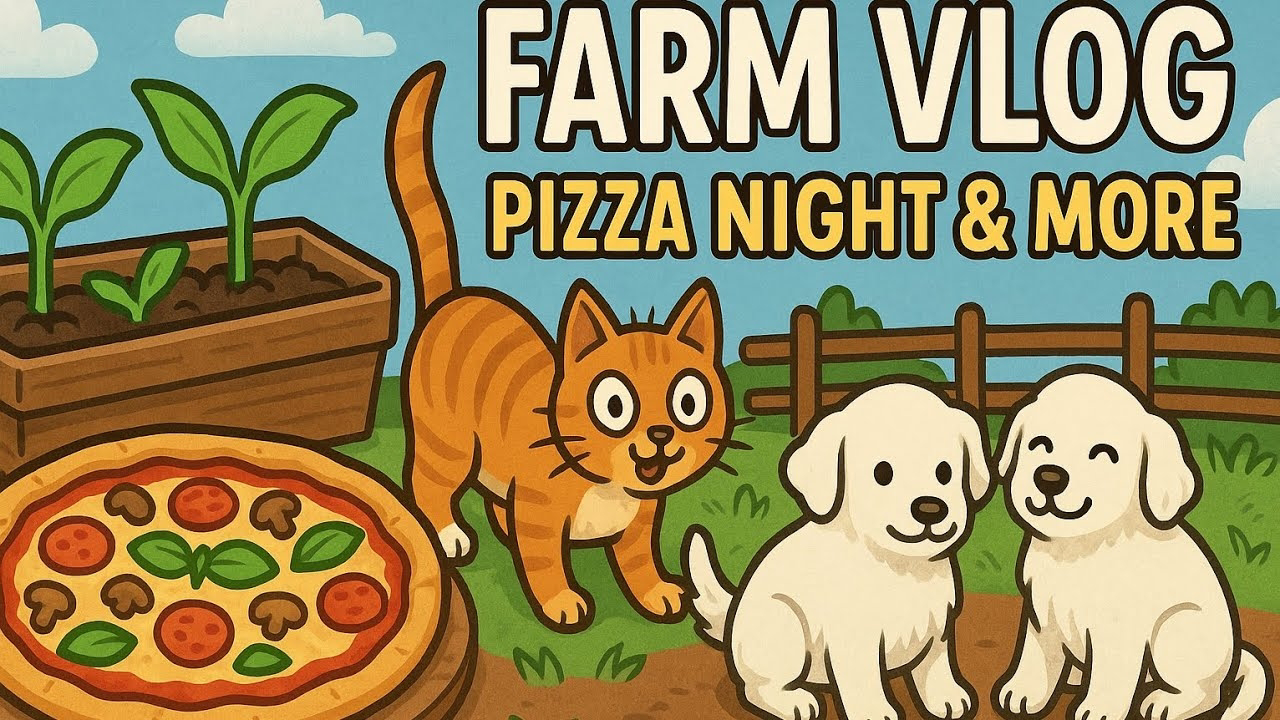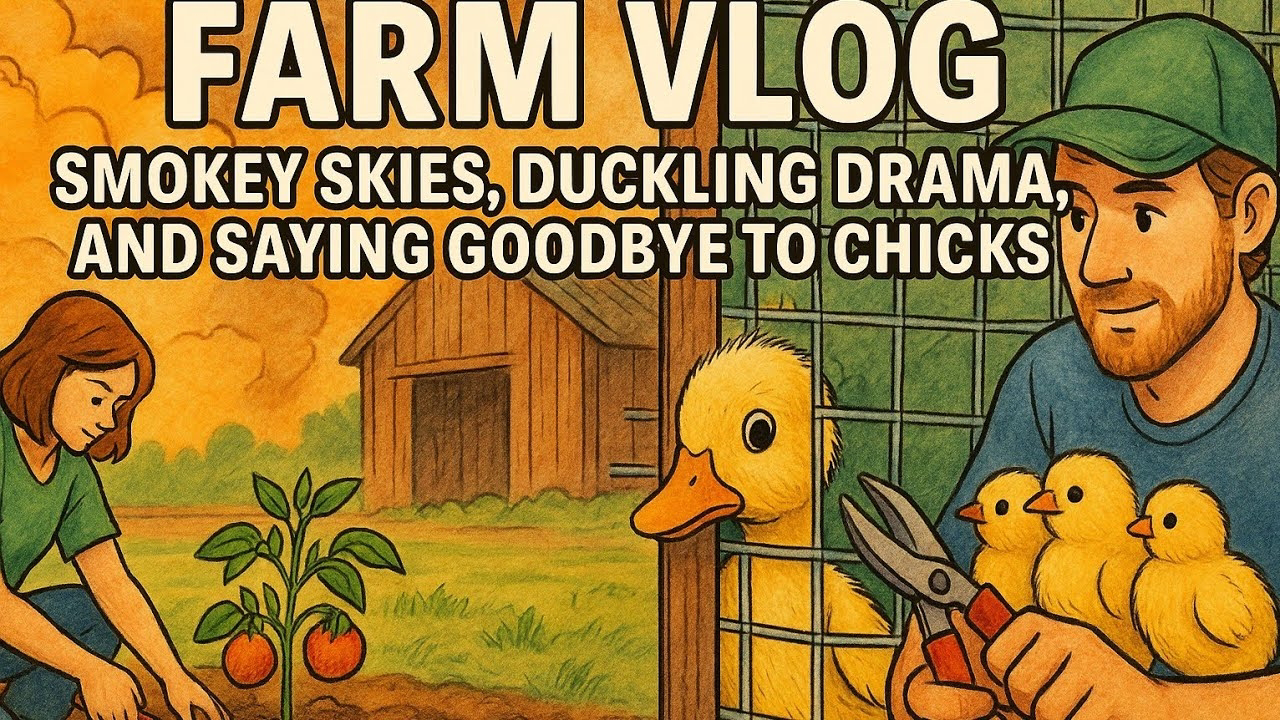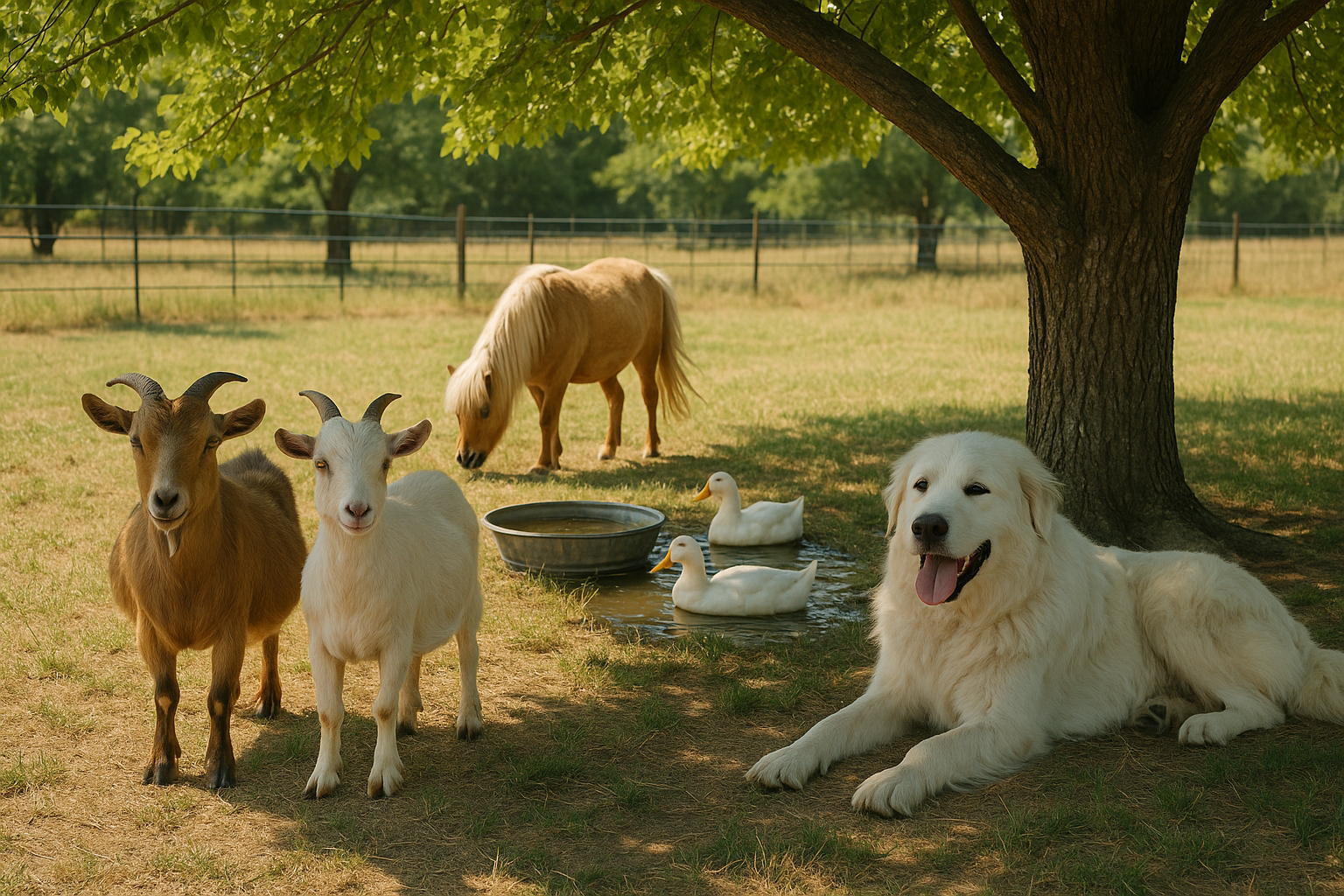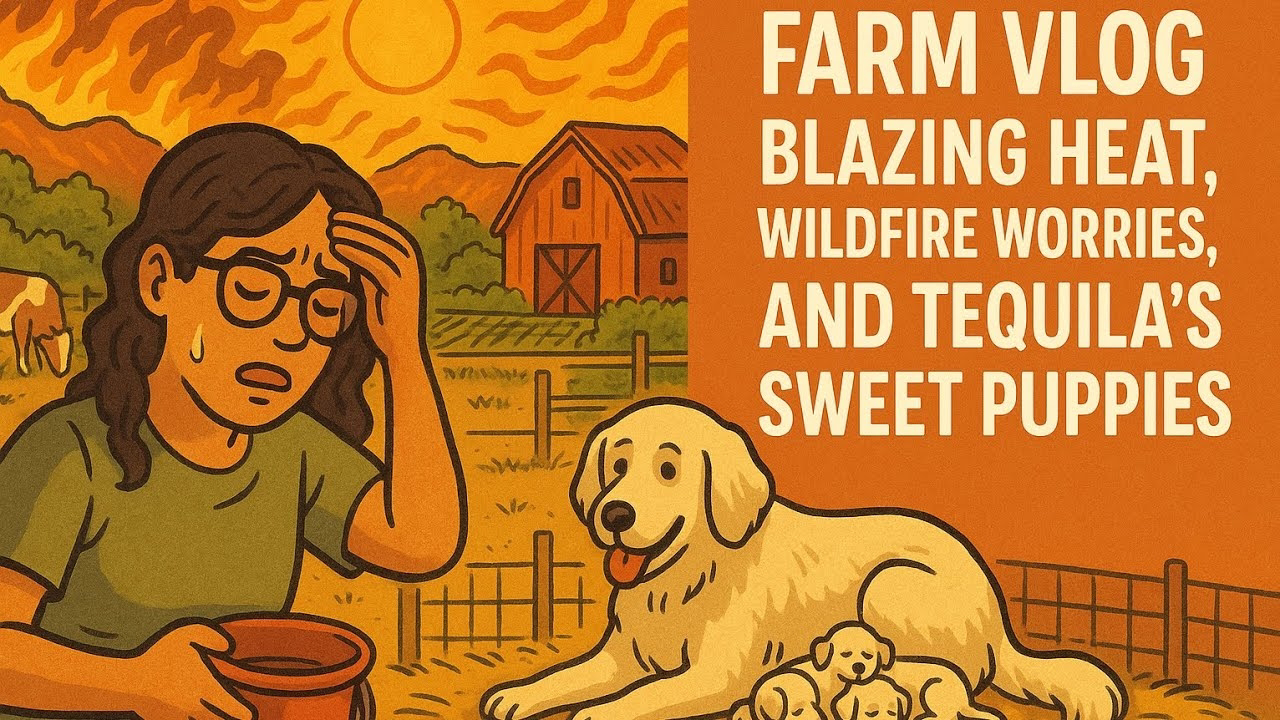Welcome to Andersen Acres! Follow our hobby farm adventures with goats, ducks, chickens, rabbits, and more. We share behind-the-scenes updates, animal care tips, and the daily chaos of farm life. Watch our latest YouTube videos and read detailed episode descriptions, all in one easy place. Whether you're into homesteading, animals, or just a bit of farm humor, you’ll feel right at home here!
Monday, June 30, 2025
Farm Vlog – Socializing Livestock Guardian Puppies With Ducks, Chickens, and Rabbits
How to Keep Chickens Cool in the Summer – Tips That Actually Work
If you're a hobby farmer, you know that summer heat isn't just uncomfortable for you — it can be downright dangerous for your chickens. Unlike us, chickens can't sweat. Instead, they rely on panting, spreading their wings, and finding shade to regulate their body temperature. But during heatwaves, those natural coping mechanisms often aren't enough. Let’s go over what actually works when it comes to keeping your flock safe, healthy, and as cool as possible.
1. Provide Plenty of Shade
The easiest and most effective way to help your chickens is to ensure they have access to lots of shade — and not just inside the coop. In fact, coops can become dangerously hot during the day. Make sure your run has natural shade from trees or add shade cloths, tarps, or even repurposed old sheets to block the sun. Rotate shade structures if needed to follow the sun’s movement.
2. Keep the Water Flowing (and Cool)
Water is critical. Chickens can’t handle dehydration well, and they drink more when it's hot. Place waterers in the shade and refill them often with cool (not ice-cold) water. Adding ice blocks or frozen water bottles to the drinkers can help keep it cooler longer. Electrolytes in the water once or twice a week during peak heat can also give them a boost.
3. Offer Frozen Treats
Yes, chickens love a popsicle moment! Try freezing fruits like watermelon chunks, berries, or corn in muffin tins of water and handing them out mid-afternoon. Not only does it give them a fun enrichment activity, but it cools them down from the inside out.
4. Ventilation Is Key
A well-ventilated coop is essential year-round but becomes life-saving in summer. Check for airflow — you want vents near the roof (heat rises!) and maybe even a fan to move air on still days. Just be sure it’s safe from dust and feathers. Never close off ventilation to “keep in cool air” — that traps heat and ammonia.
5. Dust Baths in the Shade
Chickens love to bathe in dust, and it helps them regulate temperature while warding off mites. Place dust bath areas in shaded zones and keep them dry. You can add herbs like mint or lavender for a cooling bonus (and a sweet smell!).
6. Avoid Overcrowding
Too many chickens in one space generates more body heat and reduces air circulation. Make sure your flock has enough space both in the coop and in the run to spread out and move around freely.
7. Adjust Feeding Times
Digestion generates heat. Try feeding your chickens in the early morning and later in the evening when it’s cooler. Avoid heavy feeds like cracked corn in the heat of the day, as it can increase internal body temp.
8. Watch for Signs of Heat Stress
Know the warning signs: panting, wings held away from the body, pale combs, droopy behavior, or lethargy. In severe cases, chickens may collapse. If that happens, move them to a cool place immediately, mist them lightly with cool (not cold) water, and offer electrolytes.
Final Thoughts
Keeping chickens cool in the summer takes a little planning, but it’s worth every effort to keep your flock safe and happy. When the temperatures rise, don’t wait until it’s too late — take proactive steps now to prevent heat stress.
Do you have a favorite trick to help your flock chill out? Let us know in the comments — we love learning from fellow hobby farmers!
Sunday, June 29, 2025
Farm Vlog – Injured My Back Sneezing?! But the Great Pyrenees Puppies Are Here to Help
Saturday, June 28, 2025
Farm Vlog – Saying Goodbye to Two Sweet Kittens
Friday, June 27, 2025
Farm Vlog – Permit Tests and Pyrenees Puppies (A Short But Sweet Day)
Thursday, June 26, 2025
Farm Vlog – The Most Unproductive Day on the Farm (But So Many Baby Animals!)
Wednesday, June 25, 2025
Farm Vlog – Saying Goodbye to a Kitten, Curious Crashes, and Puppy Playtime
Tuesday, June 24, 2025
Tyzzer’s Disease in Rabbits – What It Is, What to Watch For, and How to Prevent It
Farm Vlog – Exhausting Day on the Farm and a New Puppy Playpen for Our Great Pyrenees
Monday, June 23, 2025
Goat Care Basics – What Every New Owner Needs to Know
Farm Vlog – Rainy Day, Rabbit Reveal, and Chicks in the Storm!
Backyard Livestock for Beginners – What Animals Are Best (and Worst) to Start With
Starting a hobby farm or homestead is exciting—but deciding which animals to raise first can be a little overwhelming. With so many adorable options out there, it’s tempting to go all-in on every creature that catches your eye. But not all animals are beginner-friendly, and choosing the right ones can make your first year of farming a lot smoother.
At Andersen Acres, we’ve learned (sometimes the hard way!) which animals are easy keepers and which ones might need a bit more experience, infrastructure, or patience. Here’s a breakdown of some of the best—and trickiest—livestock to start with when you’re just beginning your backyard farm adventure.
🥇 The Best Backyard Livestock for Beginners
🐔 Chickens
Chickens are the classic starter animal for good reason. They’re low-maintenance, space-efficient, and incredibly rewarding. They provide fresh eggs, natural pest control, and a steady supply of compostable manure. Plus, they’re a great way to get kids involved in animal care.
Pros:
- Easy to house
- Simple diet (commercial feed + kitchen scraps)
- Egg production!
- Friendly and fun to watch
Cons:
- Need predator-proof housing
- Can be noisy or messy if unmanaged
- Broody hens might stop laying for a while
🦆 Ducks
Ducks are another excellent option, especially if you have wet areas or a small pond. They’re generally hardier than chickens when it comes to cold and wet conditions, and their eggs are prized by bakers.
Pros:
- Very cold-hardy
- Pest eaters (especially slugs!)
- Gentle personalities
- Strong egg layers (some breeds lay more than chickens)
Cons:
- Need access to water for bathing
- Can be messier than chickens (wet bedding!)
- Loud quacking, especially from females
🐐 Nigerian Dwarf or Pygmy Goats
Small goats are curious, social, and full of personality. They’re great for small-acreage farms, as long as you have secure fencing. Goats can be used for milk, brush clearing, or simply as beloved companions.
Pros:
- Entertaining and friendly
- Provide milk (if bred)
- Eat brush and weeds
Cons:
- Expert escape artists
- Require secure fencing and shelter
- Need regular hoof trimming and parasite management
🐇 Rabbits
Quiet, compact, and relatively easy to manage, rabbits are a wonderful option for smaller homesteads. Whether you’re interested in raising them for meat, fiber, or just as pets, they’re a low-noise, low-smell addition to your backyard setup.
Pros:
- Quiet and calm
- Space-saving (great for urban setups)
- Good for meat or manure
- Breed and grow quickly
Cons:
- Sensitive to heat
- Can have specific dietary needs
- Need protection from predators and drafts
⚠️ Livestock That Might Not Be Ideal for Total Beginners
These animals are wonderful, but they may require more infrastructure, knowledge, or long-term planning than most first-timers are ready for. That doesn’t mean you can’t raise them—but do your homework and be prepared!
🐄 Cows
They need a lot of space, feed, and strong fencing. Milking cows require daily commitment and knowledge about udder health, breeding, and feed quality.
🐖 Pigs
While pigs are smart and lovable, they’re also powerful diggers and can be destructive. Their care needs—especially housing and handling—can be intense for a first-time farmer.
🐎 Horses and Donkeys
Equines aren’t typically considered “livestock” in the traditional sense, but many new hobby farmers want them. They require specialized knowledge, regular hoof and dental care, and more space than many other animals.
🐑 Sheep
Sheep are sweet and productive, but they are prone to parasites, foot problems, and specific dietary issues. If you’re new to animal care, they can be a bit tricky to manage at first.
🧭 A Few Tips Before You Get Started
- Start small. You don’t need every animal all at once. Begin with one or two species and learn the ropes before expanding.
- Focus on infrastructure. Good fencing, dry shelter, and secure feed storage are more important than fancy feeders or decor.
- Connect with others. Find local homesteading groups, co-ops, or online communities for advice and moral support.
- Do your homework. Read, ask questions, and watch videos. Each species comes with its own set of quirks and challenges.
🐾 Final Thoughts
Starting your own backyard farm is incredibly rewarding—but it’s also a learning curve. By choosing beginner-friendly animals like chickens, ducks, rabbits, or small goats, you give yourself a solid foundation to build on. Over time, as your skills grow, you can expand your animal family with confidence.
Saturday, June 21, 2025
Farm Vlog – Heatwaves, Hatchlings, and Lazy Days on the Homestead
Welcome back to Andersen Acres! Today’s farm vlog is all about embracing the slower pace of a scorching hot day on the hobby farm. With the heat and humidity settling in, we focused on keeping our animals cool, our garden hydrated, and our sanity intact. Even the goats didn’t want to do much—and honestly, we didn’t blame them!
We checked in on the hatcher and were thrilled to see some Silkie chicks and young quail just starting to hatch. We also candled our duck eggs, but unfortunately, they weren’t viable—no surprise since they came from under the barn and were already old. We set the last 5 Silkie eggs in the incubator, marking the end of this round of hatching for us.
Of course, no lazy day is complete without some animal cuddles. Our adorable bunny, curious kitten, and the sweetest Great Pyrenees puppies all got some love and camera time. The puppies are really starting to show off their personalities—and we can’t wait to see who they grow into.
If you love animals, homesteading, and real-life moments on the farm, this one’s for you!
#hobbyfarming #farmvlog #homesteadinglife #raisinganimals #hatchingeggs #silkiechicks #quailchicks #puppylove #greatpyrenees #kittenlife #bunnies #lazyfarmer #heatwavehomestead
Friday, June 20, 2025
Farm Vlog – Shadowfax Roams Free, Puppy Adventures, and Pizza Night on the Homestead
Thursday, June 19, 2025
Farm Vlog – I Lost My Phone and There Were No Eggs Today
Wednesday, June 18, 2025
Farm Vlog – Baby Chicks, Fluffy Kittens, and Adorable LGD Puppies!
Tuesday, June 17, 2025
Farm Vlog – Town Errands, Kitten Goodbyes & Puppy Mayhem
Monday, June 16, 2025
The Great Goat Escape: Tales of Mischief, Mayhem, and a Very Clever Latch
There are two kinds of goats in this world: the ones that stay where you put them, and the ones that laugh at your attempts to contain them. Here at Andersen Acres, we live with the latter. Specifically, we live with Arwen, our white goat with mischievous brown spots and a brain that never stops scheming.
If you’ve ever raised goats, you already know—they’re clever. Too clever. And if you haven’t, well... let me tell you a little story.
It All Began One Peaceful Morning...
The day started like most do. The ducks were squabbling over puddles, the chickens were planning their next turf war, and Shadowfax, our ever-dramatic white miniature horse, was prancing near the fence line like he was auditioning for a fantasy movie.
I made my way out to the goat pen, expecting the usual morning chorus of bleats and head nudges. But the pen?
Empty.
Gate wide open. Not a goat in sight.
Cue the adrenaline.
The Search Begins
Now, I’ve had goats long enough to know they don’t go far—at least not right away. They’ll usually stay within snacking distance. So I started the search.
First stop: the garden. And of course, there she was—Arwen—standing in the middle of my kale patch, looking me dead in the eyes while chewing on a leaf like it was forbidden treasure.
Around her were the others, casually trampling my carefully planted rows like they were auditioning for some kind of goat-based interpretive dance.
I hollered. Arwen bolted. The others followed.
Around the Farm in 80 Seconds
The chase was on.
Through the garden.
Around the chicken coop (where she briefly tried to climb inside to check for treats).
Past the compost heap (which she sampled, of course).
And finally... up onto the porch.
I got there just in time to see Arwen standing proudly by the front door like she owned the place. She’d somehow made it past three gates, a bungee cord, and a latch I had sworn was goat-proof.
Spoiler: it wasn’t.
How Did She Do It?
After returning everyone to the pen (with the help of grain bribery and a mildly judgmental duck audience), I went back to inspect the scene of the crime.
The latch was intact, but… not locked.
Now here’s the thing—I had locked it. I was sure of it. But the gate had been opened with the precision of a creature that had watched me do it 500 times and thought, “I could do that.”
So she did.
Goat-Proofing 2.0 (and 3.0, and 4.0...)
Since that fateful morning, we’ve:
- Switched to two-step locking mechanisms
- Added carabiners and clips to every latch
- Installed a second gate inside the first (because one gate clearly isn't enough)
- And started keeping a closer eye on Arwen—our resident escape artist
Do any of these things stop her forever? No. But they slow her down. And on a farm, sometimes that’s all you can ask for.
Tips for Managing Mischievous Goats
If you’re new to goats—or just trying to outwit your own little four-legged mastermind—here are a few things I’ve learned:
- Never underestimate a goat. If you think they can’t reach it, open it, or climb it... they probably already have.
- Lock everything. Then lock it again.
- Routine is their blueprint. They watch what you do. Switch it up.
- Enrichment matters. Bored goats cause chaos. Provide climbing structures, toys, and challenges to keep them busy (and less likely to challenge your fences).
- Always keep grain handy. It’s not a bribe if it works.
A Day in the Life at Andersen Acres
Life on the farm is many things—chaotic, joyful, frustrating, hilarious—and nowhere is that more true than when goats are involved.
We wouldn’t trade it for anything.
Even when Arwen’s outsmarted us (again), even when the garden is in ruins, and even when I’ve had to climb under the porch to retrieve a goat who just had to see what was under there… I still laugh.
Because that’s farming. That’s goats. And honestly, that’s what makes Andersen Acres feel like home.
Have you had a goat escape artist of your own? Drop your favorite farmyard mischief stories in the comments—I could use the moral support.
Until next time, may your gates stay shut and your goats stay put.
🐐💚
Farm Vlog - Baby Bunnies, Wild Puppies, and a Bittersweet Loss
Sunday, June 15, 2025
Farm Vlog – Predator Trouble, Baby Bunnies, and Hope for New Chicks
Saturday, June 14, 2025
Farm Vlog - Bunny Swap, Homemade Butter, and Growing Puppies!
Friday, June 13, 2025
Farm Vlog – Bittersweet Goodbyes and New Beginnings on the Farm
Thursday, June 12, 2025
Farm Vlog - Baby Bunnies, Duck Eggs, and Lazy Day Chores
Wednesday, June 11, 2025
Farm Vlog – Puppies, Duck Eggs & Distractions!
Tuesday, June 10, 2025
Farm Vlog - Duck Drama, Bunny Babies, and Puppy Snuggles!
Monday, June 9, 2025
Mud, Mayhem, and Mini Goats: A Day on the Farm You Didn’t See Coming
There’s something magical about hobby farming. The fresh air. The satisfaction of growing your own food. The connection with the land and animals. And of course—the chaos. If you’ve ever tried to do chores in a thunderstorm with a goat on your heels and a duck in your boot, you know exactly what I mean.
Welcome to a day in the life at Andersen Acres, where we embrace the muddy, messy, utterly ridiculous reality of hobby farming—and we wouldn’t have it any other way.
Morning Comes Early (But Not Quietly)
The day begins before the sun’s properly up and way before I’ve had enough coffee. One of the miniature goats has decided the hay feeder is obviously a launching pad, and the ducks are conducting a full-volume meeting in their kiddie pool. Somewhere, a chicken is screaming. Why? No one knows. Chickens just do that sometimes.
I pull on mismatched boots—because who has time to find a matching pair when a bunny might be giving birth—and step outside to the symphony of honks, bleats, and crows that is our morning routine.
And then it hits me. The smell.
Yep. It rained last night.
Mud: The Fifth Element
Mud isn’t just a part of farm life—it’s a way of life. There’s mud in the pasture, mud in the barn, mud on my shirt, and inexplicably, mud on the ceiling of the feed shed. I don’t even ask anymore. I just accept it like one accepts gravity.
But it’s not all bad. Mud means the ducks are thrilled. They splash around like it’s their birthday. The goats, however, act like they’ve been personally insulted by the weather. Shadowfax (our white mini horse and part-time drama queen) stands on a single dry patch, refusing to move. He looks at me like this is my fault.
And maybe it is.
Chores Wait for No One
Rain or shine, farm chores never take a day off. There are eggs to collect, waters to change, bottles to feed, bedding to fluff, and fences to inspect (again). Always with the fences.
Today, we discover that one of the rabbits has kindled—meaning there are tiny, squirmy, brand-new babies in a fluffy nest. This is one of the few farm moments that brings everyone to a complete halt. Even the goats seem intrigued.
The kits are healthy, warm, and snuggled in tight. Their mom, Deli (a glossy black Rex rabbit), munches her hay like she didn’t just bring a whole litter into the world overnight. Honestly, the rabbits are some of the most chill mothers on the farm.
Meanwhile, in the Garden…
With spring in full swing, the indoor lettuce experiment is in motion. Yes, I’m growing lettuce in a jar. No, I’m not just trying to be quirky. Okay, maybe a little.
The truth is, our outdoor garden is still in the “pre-spring mud pit” stage, so growing greens indoors means I can get a jump on fresh salads while waiting for the raised beds to dry out. Plus, there’s something satisfying about watching little roots stretch through the glass like botanical spider legs.
Some of the kids think I’m just growing science experiments. They’re not entirely wrong.
Escape Artists and Goaty Shenanigans
If you’ve ever owned goats, you know they come with a PhD in Escapology. Today, Arwen (our spotted white goat and queen of calm) manages to slip out of her pen without unlocking the gate. I still don’t know how she did it.
She’s not causing trouble, just quietly chewing cud on the porch like she lives here now. And honestly? She kind of does.
After relocating Her Majesty back to the barnyard, I check fences (again). Goat-proofing is a myth. You can only goat-delay, never goat-prevent.
The Great Egg Mystery
Every few weeks, one of our hens goes rogue and decides the nesting boxes are so last season. She finds a new, secret spot to lay eggs, and I get to play “barnyard Easter egg hunt” while muttering about chickens and their dramatic tendencies.
Today, I find the hidden stash under the hay bale stack. I retrieve a dozen warm, unwashed eggs and feel like a triumphant archaeologist.
The hen watches me from her perch, looking distinctly unimpressed.
Midday Mayhem
Lunch on the farm is often a team effort. Today’s special is “whatever’s in the fridge,” plus a slice of leftover sourdough and goat cheese (homemade, of course). The ducks beg for scraps. The mini horse glares through the kitchen window. He has a nose for carrots and the eyes of a seasoned guilt-tripper.
This is also when I usually film a quick clip for our YouTube channel—Andersen Acres—updating our lovely viewers on the latest animal antics, garden experiments, and sometimes, just me laughing at my own chaos. It’s part diary, part how-to, part reality show with goats.
Afternoon Projects and “Just One More Thing…”
There’s always one more thing on the to-do list. Fix the drip on the hose bib. Start seeds for the next garden bed. Trim Shadowfax’s forelock so he can see again. Bake something because the eggs are piling up.
Today’s “just one more thing” involves trying to get the Cayuga ducks into their night pen before they realize it’s bedtime. Cayugas are beautiful, with their iridescent black feathers, but they are also wily. They know the bedtime routine and they will absolutely pretend not to.
After several loops around the barn and a few well-placed bribes (peas), everyone is safely tucked in.
Sunset and the Slow Down
Evenings on the farm are magical in a way that’s hard to describe. The animals settle. The sky turns cotton-candy pink. The barn lights flicker on. There’s a peace that settles in, even if my boots are still muddy and I still haven’t found my left glove.
I take a moment to breathe, to scratch Shadowfax behind the ears, to tell Arwen she’s a good girl (even if she did escape again), and to count the ducks before closing the gate.
Why We Do It
Farming isn’t glamorous. It’s not always Instagram-worthy. Some days it’s poop and panic. Some days it’s baby bunnies and sun-warmed tomatoes. But every day, it’s real. It’s meaningful. And it’s full of heart.
At Andersen Acres, we’re not just raising animals. We’re raising experiences, stories, laughter, and memories. One muddy, goat-filled day at a time.
🐓 Want More Chaos and Cuteness?
Make sure to follow along on YouTube for daily farm vlogs, tutorials, animal spotlights, and more behind-the-scenes fun. Drop us a comment—tell us your favorite farm animal, or share your own hobby farm story!
Farm Vlog – Baby Bunnies, Rainy Days, Indoor Lettuce & Puppy Cuddles
Sunday, June 8, 2025
Farm Vlog - Rain at Last, Baby Chicks & Quail, and Tequila's 9-Day-Old Puppies
Saturday, June 7, 2025
Top Hobby Farm Challenges (and How We Actually Handle Them)
Farm Vlog – Surprise Kittens, Garden Work, and Farm Life When You're Sick
Farm Talk - What No One Tells You About Starting a Hobby Farm
Friday, June 6, 2025
Farm Vlog - Pizza Night, Early Hatchlings, and Puppies on Wobbly Legs!
Thursday, June 5, 2025
What to Expect When Your Dog Goes Into Labor – Tequila's Puppies Are Here!
Farm Vlog – Smokey Skies, Duckling Drama, and Saying Goodbye to Chicks
Wednesday, June 4, 2025
Farm Vlog – Predator Problems, Chicks for Sale, Baby Bunnies, and Homemade Butter
Tuesday, June 3, 2025
Farm Vlog – Rain, Quail Eggs, Tequila’s Puppies & a Very Kissy Mini Horse
Monday, June 2, 2025
Beat the Heat – How We Keep Our Animals Cool in a Scorching Summer
Summers on the farm can be brutal. The sun is high, the ground is dry, and the animals? They’re just as miserable as we are. At Andersen Acres, we’ve had to get creative to help our furry and feathered friends stay safe, healthy, and as comfortable as possible during sweltering days. If you’re a fellow hobby farmer or just curious how we manage the madness, here’s a peek at how we beat the heat—farm style.
Shade, Shade, and More Shade
The first and most important defense? Shade. Trees, lean-tos, tarps, and purpose-built shelters are scattered across our pastures and pens. Our goats love lounging in the shadow of a barn wall. The ducks waddle from one shaded spot to another like feathery nomads chasing the moving sun. And our mini horse Shadowfax? He has his own shady kingdom and he knows it.
Water Is Everything
Buckets, troughs, baby pools, and even a few strategically placed mud puddles—it’s all fair game. We check and refill water several times a day. Goats are notorious for tipping their buckets (for fun, apparently), so we anchor those now. The ducks spend most of the day floating like royalty in their pool, splashing, dunking, and cooling their feet.
Frozen Treats for Everyone
Hot afternoon? Time for popsicles—farm-style. Frozen watermelon for the goats, ice cubes in the chickens’ water, frozen veggie blocks for the ducks. Even our livestock guardian dogs get their own frozen broth treats packed with kibble. It’s enrichment and hydration all in one.
Strategic Soaking
When it gets really hot, we pull out the hose. The ducks are thrilled. The goats… have opinions. Some run from it like it’s lava. Others lean into the mist like they’re on a spa retreat. We’ve learned each animal’s comfort level and we soak pens or spray the air without causing a stampede.
Fans and Ventilation in the Barn
Our barn is outfitted with large fans that keep air moving and help reduce heat stress in the enclosed areas. Proper ventilation is a must when temperatures spike, especially for our rabbits and poultry. On the hottest days, we even place frozen water bottles inside the rabbit hutches so they can lean against them if they get too warm.
The Power of Schedule Shifts
Just like us, the animals don’t want to do anything when it’s blazing hot. So we shift our schedule too—chores happen early in the morning and late in the evening. Midday is reserved for hiding in the shade and checking on everyone without too much fuss.
Know the Signs of Heat Stress
We’re always on the lookout for warning signs: panting, lethargy, drooling (in species that shouldn’t), open-mouth breathing, and animals isolating themselves. Early intervention is everything. Sometimes, just moving an animal into deeper shade and misting them can prevent a real emergency.
The Bottom Line
Keeping animals cool during a heatwave isn’t easy—but it is possible with planning, creativity, and a willingness to sweat right alongside them. Here on Andersen Acres, we believe that caring for our animals means adapting right along with the weather. Because while they can’t turn on the AC, they can count on us.
How do you help your animals beat the heat? Drop a comment and share your favorite summer farm hacks!






